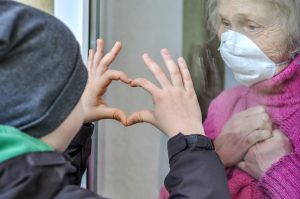عوامل الخطر المُتعلّقة بكوفيد – 19 – لمحة عامة

Coronavirus disease 2019 (COVID-19) has affected large parts of the world and has now reached pandemic status. As of June 29th 2020, the virus had spread to 188 countries with more than 10 million cases and over 500,000 deaths worldwide.
The disease is caused by a novel respiratory virus called Severe Acute Respiratory Syndrome Coronavirus 2 (SARS CoV-2). The fact that it is novel means that most individuals who encounter the virus have no immunological memory of it. Immunological memory is an innate programming mechanism that has been key to our survival as a species for centuries; it occurs when we are exposed to a pathogen that we have already encountered or been vaccinated against. The memory of this previous immune response enhances the ability of the immune system to fight the virus when it is exposed to it again. This is seen with pathogens such as the influenza virus.
Being exposed to a pathogen earlier in life gives one the best chance of acquiring the immunological memory to effectively fight it again later in life. This is because the immune system is in its most malleable, healthy and responsive state in young individuals. Antibodies are a fundamental part of the immune system; they are the body’s soldiers, armed with information and secret codes that enable them to combat enemies effectively. The novelty of SARS CoV-2 puts certain individuals at a high risk because their soldiers, for this particular enemy, have not been trained at all.
More data is emerging on the variability of outcomes caused by COVID-19. The infection affects populations and individuals in different ways, and this seems to be dependent on a combination of biological, socioeconomic, or sociodemographic factors, which may or may not be linked to underlying health conditions. Some individuals may be infected with the virus and not experience any symptoms, whilst the same infection in others may cause severe respiratory disease, multi-organ failure, and death.
Case-fatality rates: the COVID-19 death rate as a proportion of the total number of diagnosed cases.
Case-fatality rates vary worldwide; data gathered by Johns Hopkins University to date shows rates ranging from 0–23% across different countries. This suggests that there are ethnic and socioeconomic factors that contribute to the risk of dying from COVID-19. As more data emerges, and with further research, the clinical and scientific community will begin to understand the role that genetic, social, and cultural factors play in controlling the rates and outcomes of infection. Provision of updated, evidence-based information using the most recent clinical research and data will help mitigate the spread of the infection, and protect those who are more vulnerable around us.
Nabta has produced a set of articles that explore the different risk factors that make individuals more vulnerable to the acquisition of severe or critical symptoms following infection with SARS CoV-2, based on the most current reports and research:
- COVID-19 Risk Factors – Demographics: Gender.
- COVID-19 Risk Factors – Demographics: Age.
- COVID-19 Risk Factors – Demographics: Weight.
- COVID-19 Risk Factors – Underlying Health Conditions: Diabetes.
- COVID-19 Risk Factors – Underlying Health Conditions: Cardiovascular Disease.
- COVID-19 Risk Factors – Underlying Health Conditions: Chronic lung conditions.
- COVID-19 Risk Factors – Underlying Health Conditions: Cancer.
- COVID-19 Risk Factors – Underlying Health Conditions: Liver Disease.
- COVID-19 Risk Factors – Underlying Health Conditions: Kidney Disease.
- COVID-19 Risk Factors – Others: HIV/AIDS.
- COVID-19 Risk Factors – Others: Smoking.
- COVID-19 Risk Factors – Others: Immunosuppressed Individuals.
- COVID-19 Risk Factors – Others: Environment.
Whilst there is a huge amount of active research by international bodies into better understanding and tackling this invisible but powerful enemy, significantly more work is required. The scientific and clinical community have a need to decipher those additional factors that place seemingly healthy individuals at risk. More importantly, because of the variability in response to SARS CoV-2, understanding what and how molecular and genetic mechanisms govern and drive COVID-19 pathogenesis is key.
Unfortunately, a significant number of reports and efforts to date are driven by the need to publish work and acquire additional funding. What we need is accurate and careful experimental design that offers evidence-based solutions, treatments, and results that are safe and efficacious for those who are vulnerable and at the highest risk.
For now, if you are considered high risk, ensure that your current health status is as good as possible and that medication, where required, is taken appropriately.
If you have been exposed to the virus and need to visit a health care facility, call ahead to alert them to the fact that you may be infectious. They will advise you on the correct precautionary steps to take to safeguard your health and that of others. If you are in a country that has implemented tools to alert or monitor infected or potentially infected individuals, you may wish to adopt some of those tools to protect those around you and reduce the chance of cross-contamination.
It is worthwhile to note that not all individuals in a high risk category will experience severe symptoms, even if they are exposed to SARS CoV-2. However, minimising your risk of infection is certainly advisable. Take steps such as following good respiratory hygiene, maintaining distance between yourself and others when in public and washing your hands regularly. The World Health Organisation provides thorough information on protection during this pandemic, and this guidance should be more strictly implemented if you are in a high risk category. In general, anyone in this category should take general measures to maintain a healthy lifestyle by partaking in regular exercise and maintaining a healthy diet.
The general recommendation is to limit hospital visits and contact with healthcare facilities when possible. If you have a chronic condition and require ongoing medical care or monitoring, consider using telephone or electronic consultations if this facility is available to you, after discussion with your healthcare provider or doctor. Remote or home-based care is possible in some cases. If you are considered high risk and require medications or a pharmacy visit, consider asking others who are less vulnerable to pick up what is needed. It is important to keep taking your medications as recommended.
Nabta Health is committed to providing you with the most up to date, peer-reviewed, clinically- and scientifically-validated information on COVID-19 and other conditions. If you are not sure what your, or your loved ones’, risk factors are, Nabta Health has built an electronic risk assessment questionnaire, which can be accessed from our Application. The Nabta App can be downloaded from our website (www.nabtahealth.com).
Sources:
- “COVID-19 Map.” Johns Hopkins Coronavirus Resource Center, coronavirus.jhu.edu/map.html.
- “Groups at Higher Risk for Severe Illness.” Centers for Disease Control and Prevention, Centers for Disease Control and Prevention, www.cdc.gov/coronavirus/2019-ncov/need-extra-precautions/groups-at-higher-risk.html.
- “Q&A On Coronaviruses (COVID-19).” World Health Organization, World Health Organization, www.who.int/emergencies/diseases/novel-coronavirus-2019/question-and-answers-hub/q-a-detail/q-a-coronaviruses.









